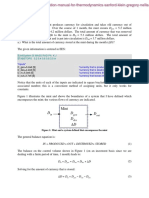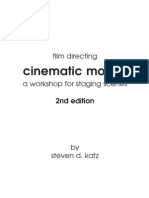The Five Cs of Cinematography PDF
The Five Cs of Cinematography PDF
Uploaded by
ryanCopyright:
Available Formats
The Five Cs of Cinematography PDF
The Five Cs of Cinematography PDF
Uploaded by
ryanOriginal Title
Copyright
Available Formats
Share this document
Did you find this document useful?
Is this content inappropriate?
Copyright:
Available Formats
The Five Cs of Cinematography PDF
The Five Cs of Cinematography PDF
Uploaded by
ryanCopyright:
Available Formats
Article
by STEWART REDWINE
The Five C’s of Cinematography
by Joseph V. Mascelli
I n the technological Xanadu we video producers know as the present day it is
easy for outsiders, and some insiders, to forget the person telling the story and
somehow think that the camera being used impacts the quality of the story being
told. Recently, someone who had seen the short film content produced by Christ in
Youth (where I work as a producer) had only one question for me about our vid-
eos. Did they want to know who shot it? No. They wanted to know what camera we
used.
If you think what camera you shoot on is the answer to great way to film the subject – but seem unable to explain just
videos, then I challenge you with this. Go make a big pile of how they do it.”
money doing whatever you want. Maybe radio ad sales, or invent
an alternative energy source for fossil fuels. Once you have the Almost 50 years after the publishing of these words I want
cash, you can buy the very best camera. Then you’ll be able to to re-assure Joseph V. Mascelli that he succeeded in explaining
make the best videos, right? Wrong. Cameras don’t tell stories, cinematography in an easy-to-understand way. He did this by ex-
people do. Since this is the case, there is really only one thing you plaining everything about cinematography in five categories that
need to tell great stories with the videos you produce, YOU. have one common thread – cinematography, like all other aspects
However, none of us are born knowing anything about of video production, functions at its peak performance when it
the tools of the trade needed to produce videos. In an effort to serves the story.
improve the one tool all video producers have in common, their So what are the Five C’s? They are camera angles,
mind, a must have addition to every video producer’s library is continuity, cutting, close-ups, and composition. I want to share
Joseph V. Mascelli’s The Five C’s of Cinematography. I picked with you some of my favorite quotes from each one of the Five
this book up a few years ago and I have learned more from it than C’s. Consider this article the cliff notes version of the book; and,
any other resource on the subject. I’ve been to courses, classes, just like your English teacher, I strongly encourage you to read
looked to chat rooms online, and experimented by trial and error; The Five C’s of Cinematography in it’s entirety in addition to
but, none of those things have come close to the pure un-distilled this summary (you can click here to get it at Amazon.com ).
story driven explanation of cinematography found in Mascelli’s
classic book. 1. Camera Angles
“Camera placement is determined by narrative significance.”
In his own words from the introduction:
“On many occasions during the years devoted to preparation This is very important. Why are you looking at what you are
and writing of this book, I have felt that defining, explaining, looking at? Is it because it looks good or because we need to see
clarifying and graphically illustrating motion picture filming it to move the story along? It should always be to move the story
techniques in an easy-to-understand way – is impossible – along, sometimes both, never solely because it looks good.
but not quite. Most professionals instinctively know the right
Christian Video® Magazine November 2009 21
Article
by STEWART REDWINE
2. Continuity are making videos for others you are not the beholder. The most
“Good continuity encourages the viewer to become absorbed important set of eyes belong to the audience. Make sure you are
in the story-telling, without bothersome distractions. The making images that look good to your audience, and above all
prime purpose of a motion picture, whether theatrical fiction else, serve the story.
feature or documentary fact film, is to capture and hold audi-
ence attention – from opening shot to final fade-out.” 6. The Sixth C
In closing, there is a sixth C of Cinematography I would like
This entire chapter breaks down the nuts and bolts of pho- to mention: Compliment. When you are in the process of shoot-
tographing action in such a way that it makes sense on screen. ing or have just finished watching a video you think looked great,
I haven’t come across a better explanation of “the line” (action make sure you tell the person or group of people who produced
axis/maintaining dynamic and static screen direction) in any the video. After all, none of us video producers are making
other book. videos just for ourselves. As you continue to strive to be the
best you can be take the time to compliment others on their own
3. Cutting successes along the way. Oscar Wilde said it best, “Anybody can
“Always move players into and out of close-ups to allow sympathize with the sufferings of a friend, but it requires a very
cutting on action.” fine nature to sympathize with a friend’s success”. The sixth C of
Cinematography may just be the most important. Make sure you
Cut on the action. This simple axiom of editing works every compliment others whenever you can. After all, we’re all creating
time. videos for others and we want to know if we succeeded in com-
municating our story.
“It is possible to cut away to anything happening anywhere
at any time.” All quotations from The Five C’s of Cinematography by Joseph
V. Mascelli – 1965 - Silman James Press
Remember this. You are in the driver’s seat. You are the one
putting one shot after the other. What do you want the specific Written by Stewart H. Redwine
series of sights and sounds you’re placing in order to mean? Stewart H. Redwine is a Video Producer for Christ in Youth
as well as Producer and Director of Photography for onetime-
“Each shot should make a point. All scenes should be linked blind’s hit mini-movies and Youth Specialties 36 Parables
together so that their combined effect, rather than their indi- DVD series.
vidual contents, produces the desired audience reactions.” He enjoys writing, tending his garden, and slalom skiing in
the gorgeous Ozark Mountain Country of Southwest Missouri
4. Close-Ups where he lives with his wife and two children. You can read more
Close-ups should be made to count. The stronger the motive of what he has to say about faith, culture, and the arts at Stewar-
for using a close-up, the more the close-up can help make tHRedwine.com.
the story-telling truly effective!
The consistent emphasis throughout the five sections of the
book is this; every shot must serve the story.
5. Composition
“Good composition is arrangement of pictorial elements to
form a unified harmonious whole.”
Beauty is in the eye of the beholder. However, when you
Christian Video® Magazine November 2009 22
You might also like
- David Mamet - On Directing Film-Viking Adult (1991)Document103 pagesDavid Mamet - On Directing Film-Viking Adult (1991)yusqincay418267% (3)
- Zombie Reddy Pitch DeckDocument16 pagesZombie Reddy Pitch Deckcarlo ancellottiNo ratings yet
- How Not To Make A Short FilmDocument282 pagesHow Not To Make A Short FilmAshish_Singh_512681% (16)
- On The Set: The Hidden Rules of Movie Making EtiquetteFrom EverandOn The Set: The Hidden Rules of Movie Making EtiquetteRating: 3 out of 5 stars3/5 (2)
- Film Pitch Deck TemplateDocument18 pagesFilm Pitch Deck TemplateVaibhav Ingole100% (1)
- FILM 5 Directors Treatment TemplateDocument1 pageFILM 5 Directors Treatment TemplateGracia Putri100% (1)
- Crew Contact List Sample PDFDocument3 pagesCrew Contact List Sample PDFNoble Creature100% (1)
- Guerilla Film Makers PLUS PDFDocument54 pagesGuerilla Film Makers PLUS PDFAdrià Guxens100% (1)
- The Directors Six SensesDocument31 pagesThe Directors Six SensesMichael Wiese Productions93% (14)
- DirectingFeatureFilms SecDocument22 pagesDirectingFeatureFilms SecSreedevi Bethapudi50% (2)
- Books To DownloadDocument27 pagesBooks To DownloadSurya Prakasam0% (1)
- Cinematography SyllabusDocument1 pageCinematography Syllabustanzil mohmud shah100% (1)
- MISHAN IMPOSSIBLE Pitch Deck 2.1Document16 pagesMISHAN IMPOSSIBLE Pitch Deck 2.1Ravi Kanth100% (2)
- Writing Short Film Scripts 10 PagesDocument10 pagesWriting Short Film Scripts 10 Pagessgang007100% (1)
- 26 Short Screenplays For Independent Filmmakers - Table of ContentsDocument12 pages26 Short Screenplays For Independent Filmmakers - Table of Contents26Screenplays100% (1)
- Gulfstream GV-Flight - Controls PDFDocument38 pagesGulfstream GV-Flight - Controls PDFGourav DasNo ratings yet
- Master Shots Vol.2 Sample255Document24 pagesMaster Shots Vol.2 Sample255ANGELO TORRESNo ratings yet
- Solution Manual Thermodynamics Sanford KleinDocument65 pagesSolution Manual Thermodynamics Sanford KleinMonica estefania Leal bossaNo ratings yet
- Writing For The ScreenDocument9 pagesWriting For The Screensam rehmanNo ratings yet
- Master Shots Volume 2 - Shooting Great Dialogue ScenesDocument183 pagesMaster Shots Volume 2 - Shooting Great Dialogue ScenesJagadeesh Korimilla80% (5)
- Smartphone Filmmaking Guide: Bessie Young, MFA, MSDocument7 pagesSmartphone Filmmaking Guide: Bessie Young, MFA, MSSubid Choudhury100% (1)
- Filmmaking Guide Primary PDFDocument19 pagesFilmmaking Guide Primary PDFprakashNo ratings yet
- Official Feature Film Pitch Deck: Alejandro Montoya MarinDocument17 pagesOfficial Feature Film Pitch Deck: Alejandro Montoya MarinNemanjaBogdanovicNo ratings yet
- Primary Filmmaking GuideDocument20 pagesPrimary Filmmaking GuideAlejandro Catalini100% (3)
- The Filmmaker's HandbookDocument3 pagesThe Filmmaker's HandbookHogj Sky71% (7)
- Between The Scenes Sample PDFDocument21 pagesBetween The Scenes Sample PDFMichael Wiese Productions100% (8)
- 10 Compositional Theories of CinematographyDocument15 pages10 Compositional Theories of CinematographyNafizAlam67% (3)
- Short Film-BookletDocument29 pagesShort Film-Bookletapi-433807172No ratings yet
- Dialogue NotesDocument16 pagesDialogue NotesVikramNo ratings yet
- Kisi-Kisi Tes Masuk Ppds Bedah Umum Fkui April 2011Document18 pagesKisi-Kisi Tes Masuk Ppds Bedah Umum Fkui April 2011David SantosoNo ratings yet
- Memorial Professional Letter of AppraisalDocument2 pagesMemorial Professional Letter of AppraisalSubhobroto Mukherjee100% (1)
- Cinematic MotionDocument374 pagesCinematic MotionJennifer Vanessa Silva100% (3)
- 5C's of Cinematography: Movie - BabyDocument2 pages5C's of Cinematography: Movie - BabyNatashaNo ratings yet
- Film Management Auto Saved)Document52 pagesFilm Management Auto Saved)Jyoti SharmaNo ratings yet
- Writing Short Film Scripts 10 PagesDocument10 pagesWriting Short Film Scripts 10 PageskkkkNo ratings yet
- Arjun ReddyDocument2 pagesArjun ReddySimon DevramNo ratings yet
- Filmmaking Technique ScreenwritingDocument102 pagesFilmmaking Technique ScreenwritingGato Huynh100% (3)
- Film Pitch - Target of WealthDocument9 pagesFilm Pitch - Target of WealthSophie SheenNo ratings yet
- Film DirectingDocument112 pagesFilm DirectingBen100% (2)
- An Introduction To Shot Types and Camera Movement: Creative Media ProductionDocument44 pagesAn Introduction To Shot Types and Camera Movement: Creative Media ProductionMubashar Naqvi100% (1)
- Movie TipsDocument5 pagesMovie TipsSurekha SettyNo ratings yet
- Screenwriting FormatDocument5 pagesScreenwriting FormatDiem Judilla100% (2)
- The Bourne Identity Poster AnalysisDocument1 pageThe Bourne Identity Poster AnalysisSophie SheenNo ratings yet
- Elements of CinematographyDocument105 pagesElements of CinematographyNishtha Sharma100% (4)
- Film Directing: Cinematic Motion 2nd Edition PDF SampleDocument27 pagesFilm Directing: Cinematic Motion 2nd Edition PDF SampleMichael Wiese Productions72% (18)
- Top 10 Screenwriting Books For ScreenwritersDocument12 pagesTop 10 Screenwriting Books For ScreenwritersPablo GonzálezNo ratings yet
- Acting QuesDocument5 pagesActing QuesashishNo ratings yet
- Introduction To The Art of Film: ?V Hnmuladv WVS&NR 1Document26 pagesIntroduction To The Art of Film: ?V Hnmuladv WVS&NR 1JohnEM22No ratings yet
- Storyboarding & CinematographyDocument134 pagesStoryboarding & CinematographyAnonymous CMrrdV100% (3)
- Television Format & Style StandardsDocument10 pagesTelevision Format & Style StandardsAvra SenNo ratings yet
- Filmmaking Checklist Filmmaking Stuff1Document17 pagesFilmmaking Checklist Filmmaking Stuff1Vikash Sharma100% (7)
- 8 Types of ScriptsDocument5 pages8 Types of ScriptsShams QiamNo ratings yet
- Arya (2004 Film)Document3 pagesArya (2004 Film)bhargav470No ratings yet
- The 72hour Short Film Shootout LIVE Filmmaking Workshop PresentationDocument34 pagesThe 72hour Short Film Shootout LIVE Filmmaking Workshop PresentationJoseph A. Eulo100% (3)
- Master Shots Ebooks With HD Video and AudioDocument1 pageMaster Shots Ebooks With HD Video and AudioMichael Wiese Productions0% (8)
- Saaho Film StoryDocument1 pageSaaho Film StoryMustafa Mapkar0% (1)
- Filmmaking GlossaryDocument8 pagesFilmmaking GlossaryNathan Munn100% (2)
- Maria Tran - Info Kit - OrgDocument5 pagesMaria Tran - Info Kit - OrgMaria TrầnNo ratings yet
- The Five Cs of CinematographyDocument2 pagesThe Five Cs of Cinematographyview starNo ratings yet
- Christopher KenworthyDocument19 pagesChristopher KenworthyRoberto LucasNo ratings yet
- BookDocument20 pagesBookRian ApriansyahNo ratings yet
- Directing A FilmDocument8 pagesDirecting A FilmSayan Gupta100% (2)
- Film Art, Creative Decisions in Filmmaking 2-9Document8 pagesFilm Art, Creative Decisions in Filmmaking 2-9amandaNo ratings yet
- 16 EditingDocument4 pages16 EditingRaed ElBorniNo ratings yet
- Scapular Dyskinesis Disabled Throwing ShoulderDocument52 pagesScapular Dyskinesis Disabled Throwing Shouldersfxn2qrw7rNo ratings yet
- Birth Certificate FormDocument5 pagesBirth Certificate FormEric MitieloNo ratings yet
- Parent LetterDocument1 pageParent Letterapi-354240942No ratings yet
- SGSF 4th Edition InviteDocument11 pagesSGSF 4th Edition Invitesameelsaad1No ratings yet
- UnpublishedDocument10 pagesUnpublishedScribd Government DocsNo ratings yet
- Thesis Statement For Things Fall Apart Tragic HeroDocument7 pagesThesis Statement For Things Fall Apart Tragic Herodwk3zwbx100% (1)
- Carbo-Tec SDocument2 pagesCarbo-Tec Syehia sayedNo ratings yet
- Elite Prime Saver BrochureDocument21 pagesElite Prime Saver Brochuresunlife zeoilenNo ratings yet
- Pricelist HashkaDocument15 pagesPricelist Hashkacahyo hashkaNo ratings yet
- GR. No. 153674Document2 pagesGR. No. 153674Dan LocsinNo ratings yet
- Civic Grade 3Document3 pagesCivic Grade 3ketemu AnharNo ratings yet
- Velamma Episode 38 in Hindi in Kirtu ComDocument4 pagesVelamma Episode 38 in Hindi in Kirtu ComChinmay Mondal20% (10)
- My Body Map Health ChartDocument47 pagesMy Body Map Health ChartCandace MacDonaldNo ratings yet
- English Worksheet 8 N3Document3 pagesEnglish Worksheet 8 N3Will MendozaNo ratings yet
- Introduction To Combination of Series and Parallel CircuitsDocument16 pagesIntroduction To Combination of Series and Parallel CircuitsXmart UsmanNo ratings yet
- A Reflection of The Life Changing Experience in My LifeDocument2 pagesA Reflection of The Life Changing Experience in My LifeEricka Rivera SantosNo ratings yet
- CHAPTER 3 Clasification of LawDocument10 pagesCHAPTER 3 Clasification of LawNazatulJuhariNo ratings yet
- Aloka SSD 1400 FinalDocument2 pagesAloka SSD 1400 FinalihsanbuNo ratings yet
- Questionnaire For Successful Stakeholder AnalysisDocument8 pagesQuestionnaire For Successful Stakeholder AnalysisNashNo ratings yet
- DGA Letter To SupportersDocument1 pageDGA Letter To Supportersstephen_mistler2763No ratings yet
- Immediate Download Tactics For TOEIC Listening and Reading Test Grant Trew Ebooks 2024Document84 pagesImmediate Download Tactics For TOEIC Listening and Reading Test Grant Trew Ebooks 2024donkerzelijeNo ratings yet
- FORMTR12 ChalanDocument2 pagesFORMTR12 ChalanVinod SathyanNo ratings yet
- Extinguishing Financial Liabilities With Equity Instruments: IFRIC Interpretation 19Document8 pagesExtinguishing Financial Liabilities With Equity Instruments: IFRIC Interpretation 19rosettejoy278No ratings yet
- PNB v. Office of The President, G.R. No, 104528, 18 January 1996Document9 pagesPNB v. Office of The President, G.R. No, 104528, 18 January 1996Jennilyn Gulfan YaseNo ratings yet
- Ichimoku Kinko Hyo Trading Explained - PDF Download: Japanese ChartingDocument13 pagesIchimoku Kinko Hyo Trading Explained - PDF Download: Japanese ChartingEko Aji WahyudinNo ratings yet
- 41.effect of Simplified Kundalini Yoga Practices On Haematological and Hormonal Variables Among Medical Students Panneerselvam Periasamy 1631Document7 pages41.effect of Simplified Kundalini Yoga Practices On Haematological and Hormonal Variables Among Medical Students Panneerselvam Periasamy 1631Soumya SNo ratings yet

























































































